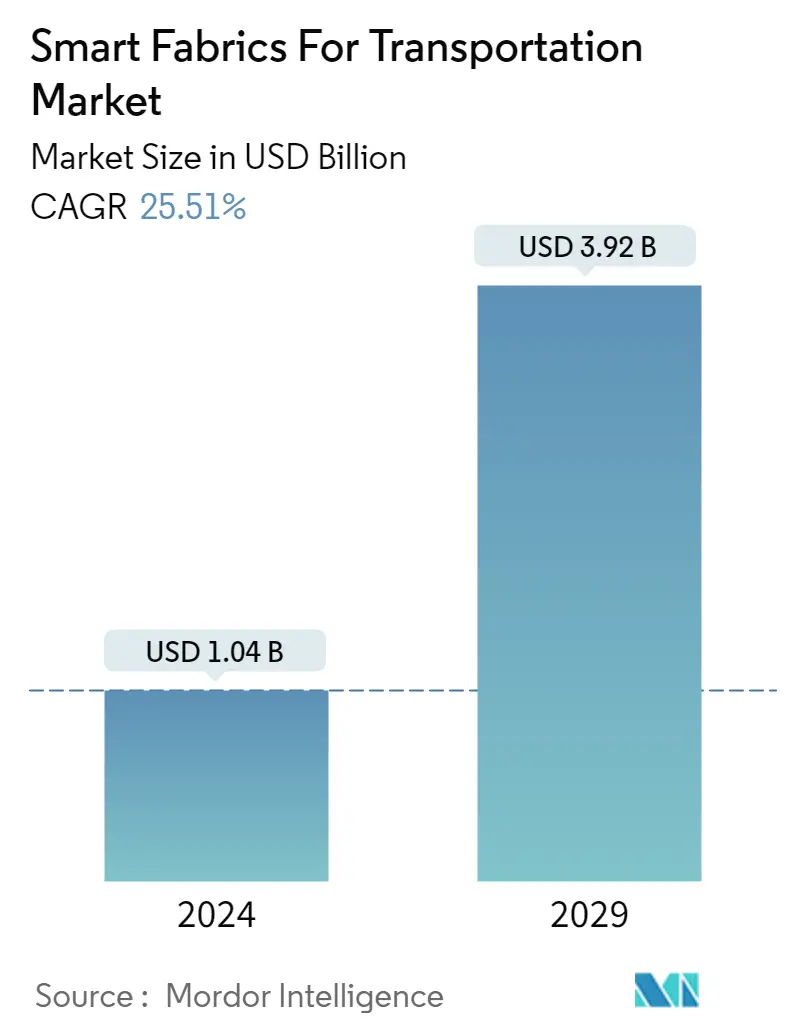Market Size of Smart Fabrics For Transportation Industry

| Study Period | 2019 - 2029 |
| Market Size (2024) | USD 1.04 Billion |
| Market Size (2029) | USD 3.92 Billion |
| CAGR (2024 - 2029) | 25.51 % |
| Fastest Growing Market | Asia Pacific |
| Largest Market | North America |
Major Players
*Disclaimer: Major Players sorted in no particular order |
Need a report that reflects how COVID-19 has impacted this market and its growth?
Smart Fabrics For Transportation Market Analysis
The Smart Fabrics For Transportation Market size is estimated at USD 1.04 billion in 2024, and is expected to reach USD 3.92 billion by 2029, growing at a CAGR of 25.51% during the forecast period (2024-2029).
- The electronics industry's drastic technological advancement has changed how people do and perceive things. The Internet of Things has connected everything. Smart fabrics are a crucial part of this technological advancement, playing a significant role in the future, with applications in the transportation industry.
- The miniaturization of various electronic components and the emergence of various advanced polymers are driving the market forward. Also, with the development of fabrics with antistatic properties, tremendous stain-proof capabilities and the overall ability of fabrics to interact with the environment, which further helps regulate temperature, are offered. These critical properties of smart fabrics have enabled their use in automotive vehicles.
- Moreover, the use of fabrics in automobiles is not only restricted to upholstery, but they are also widely used in floor mats, seat belt webbings, the interior ceiling, steering wheel, interior door panels, and gear shift covers. Additionally, fabrics are not only meant for the exterior surfaces, which are visible but are also used in the preparation of insulation for thermal control inside the vehicle. The versatile nature of the fabrics has made them a crucial component of automobiles, driving the market forward.
- The increasing adoption of bluetooth low energy (BLE) technology and miniaturization of electronic components is a crucial driver for the smart fabrics for transportation market growth. The BLE technology-enabled garments can sense and monitor data when connected to the Internet. There has been a rising trend of miniaturization of electronic components and systems, which has expedited the need for smaller assembly components for manufacturing smart fabrics. Radical developments in wireless and electronic technologies have enabled miniaturization and their integration into conductive textiles, which is expected to fuel the market growth during the forecast period.
- However, factors like slow penetration rate in developing countries, as well as lack of funding and capital expenditure, could be a matter of concern that could limit the market's overall growth throughout the forecast period.
- Further, with the outbreak of COVID-19, the market did not experience substantial growth. This is because manufacturing smart fabric needed a greater degree of automation and advancements in textile processing techniques such as electronic controlling systems, computer-aided design, automated inspection, etc. The industry did not come under the essential services segment as it was considered in the "apparel and lifestyle goods" category, resulting from which factories were not operating. However, in the post-COVID-19 market scenario, the market is expected to witness significant growth opportunities primarily due to the rising number of connected cars and heavy vehicles.
